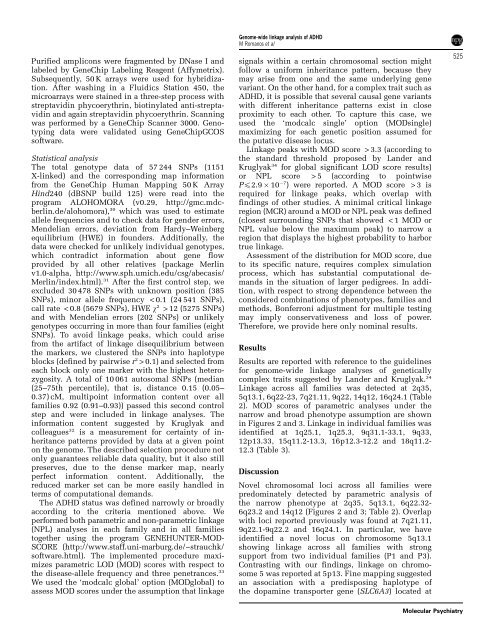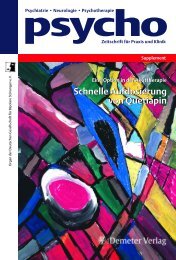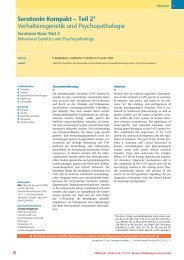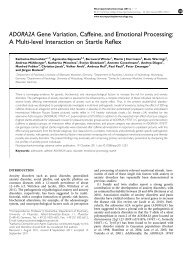Genome-wide linkage analysis of ADHD using high- density SNP ...
Genome-wide linkage analysis of ADHD using high- density SNP ...
Genome-wide linkage analysis of ADHD using high- density SNP ...
Create successful ePaper yourself
Turn your PDF publications into a flip-book with our unique Google optimized e-Paper software.
Purified amplicons were fragmented by DNase I and<br />
labeled by GeneChip Labeling Reagent (Affymetrix).<br />
Subsequently, 50 K arrays were used for hybridization.<br />
After washing in a Fluidics Station 450, the<br />
microarrays were stained in a three-step process with<br />
streptavidin phycoerythrin, biotinylated anti-streptavidin<br />
and again streptavidin phycoerythrin. Scanning<br />
was performed by a GeneChip Scanner 3000. Genotyping<br />
data were validated <strong>using</strong> GeneChipGCOS<br />
s<strong>of</strong>tware.<br />
Statistical <strong>analysis</strong><br />
The total genotype data <strong>of</strong> 57 244 <strong>SNP</strong>s (1151<br />
X-linked) and the corresponding map information<br />
from the GeneChip Human Mapping 50 K Array<br />
Hind240 (dB<strong>SNP</strong> build 125) were read into the<br />
program ALOHOMORA (v0.29, http://gmc.mdcberlin.de/alohomora),<br />
30 which was used to estimate<br />
allele frequencies and to check data for gender errors,<br />
Mendelian errors, deviation from Hardy–Weinberg<br />
equilibrium (HWE) in founders. Additionally, the<br />
data were checked for unlikely individual genotypes,<br />
which contradict information about gene flow<br />
provided by all other relatives (package Merlin<br />
v1.0-alpha, http://www.sph.umich.edu/csg/abecasis/<br />
Merlin/index.html). 31 After the first control step, we<br />
excluded 30 478 <strong>SNP</strong>s with unknown position (385<br />
<strong>SNP</strong>s), minor allele frequency < 0.1 (24 541 <strong>SNP</strong>s),<br />
call rate < 0.8 (5679 <strong>SNP</strong>s), HWE w 2 > 12 (5275 <strong>SNP</strong>s)<br />
and with Mendelian errors (202 <strong>SNP</strong>s) or unlikely<br />
genotypes occurring in more than four families (eight<br />
<strong>SNP</strong>s). To avoid <strong>linkage</strong> peaks, which could arise<br />
from the artifact <strong>of</strong> <strong>linkage</strong> disequilibrium between<br />
the markers, we clustered the <strong>SNP</strong>s into haplotype<br />
blocks (defined by pairwise r 2 > 0.1) and selected from<br />
each block only one marker with the <strong>high</strong>est heterozygosity.<br />
A total <strong>of</strong> 10 061 autosomal <strong>SNP</strong>s (median<br />
(25–75th percentile), that is, distance 0.15 (0.05–<br />
0.37) cM, multipoint information content over all<br />
families 0.92 (0.91–0.93)) passed this second control<br />
step and were included in <strong>linkage</strong> analyses. The<br />
information content suggested by Kruglyak and<br />
colleagues 32 is a measurement for certainty <strong>of</strong> inheritance<br />
patterns provided by data at a given point<br />
on the genome. The described selection procedure not<br />
only guarantees reliable data quality, but it also still<br />
preserves, due to the dense marker map, nearly<br />
perfect information content. Additionally, the<br />
reduced marker set can be more easily handled in<br />
terms <strong>of</strong> computational demands.<br />
The <strong>ADHD</strong> status was defined narrowly or broadly<br />
according to the criteria mentioned above. We<br />
performed both parametric and non-parametric <strong>linkage</strong><br />
(NPL) analyses in each family and in all families<br />
together <strong>using</strong> the program GENEHUNTER-MOD-<br />
SCORE (http://www.staff.uni-marburg.de/~strauchk/<br />
s<strong>of</strong>tware.html). The implemented procedure maximizes<br />
parametric LOD (MOD) scores with respect to<br />
the disease-allele frequency and three penetrances. 33<br />
We used the ‘modcalc global’ option (MODglobal) to<br />
assess MOD scores under the assumption that <strong>linkage</strong><br />
<strong>Genome</strong>-<strong>wide</strong> <strong>linkage</strong> <strong>analysis</strong> <strong>of</strong> <strong>ADHD</strong><br />
M Romanos et al<br />
signals within a certain chromosomal section might<br />
follow a uniform inheritance pattern, because they<br />
may arise from one and the same underlying gene<br />
variant. On the other hand, for a complex trait such as<br />
<strong>ADHD</strong>, it is possible that several causal gene variants<br />
with different inheritance patterns exist in close<br />
proximity to each other. To capture this case, we<br />
used the ‘modcalc single’ option (MODsingle)<br />
maximizing for each genetic position assumed for<br />
the putative disease locus.<br />
Linkage peaks with MOD score > 3.3 (according to<br />
the standard threshold proposed by Lander and<br />
Kruglyak 34 for global significant LOD score results)<br />
or NPL score > 5 (according to pointwise<br />
Pp2.9 10 7 ) were reported. A MOD score > 3 is<br />
required for <strong>linkage</strong> peaks, which overlap with<br />
findings <strong>of</strong> other studies. A minimal critical <strong>linkage</strong><br />
region (MCR) around a MOD or NPL peak was defined<br />
(closest surrounding <strong>SNP</strong>s that showed < 1 MOD or<br />
NPL value below the maximum peak) to narrow a<br />
region that displays the <strong>high</strong>est probability to harbor<br />
true <strong>linkage</strong>.<br />
Assessment <strong>of</strong> the distribution for MOD score, due<br />
to its specific nature, requires complex simulation<br />
process, which has substantial computational demands<br />
in the situation <strong>of</strong> larger pedigrees. In addition,<br />
with respect to strong dependence between the<br />
considered combinations <strong>of</strong> phenotypes, families and<br />
methods, Bonferroni adjustment for multiple testing<br />
may imply conservativeness and loss <strong>of</strong> power.<br />
Therefore, we provide here only nominal results.<br />
Results<br />
Results are reported with reference to the guidelines<br />
for genome-<strong>wide</strong> <strong>linkage</strong> analyses <strong>of</strong> genetically<br />
complex traits suggested by Lander and Kruglyak. 34<br />
Linkage across all families was detected at 2q35,<br />
5q13.1, 6q22-23, 7q21.11, 9q22, 14q12, 16q24.1 (Table<br />
2). MOD scores <strong>of</strong> parametric analyses under the<br />
narrow and broad phenotype assumption are shown<br />
in Figures 2 and 3. Linkage in individual families was<br />
identified at 1q25.1, 1q25.3, 9q31.1-33.1, 9q33,<br />
12p13.33, 15q11.2-13.3, 16p12.3-12.2 and 18q11.2-<br />
12.3 (Table 3).<br />
Discussion<br />
Novel chromosomal loci across all families were<br />
predominately detected by parametric <strong>analysis</strong> <strong>of</strong><br />
the narrow phenotype at 2q35, 5q13.1, 6q22.32-<br />
6q23.2 and 14q12 (Figures 2 and 3; Table 2). Overlap<br />
with loci reported previously was found at 7q21.11,<br />
9q22.1-9q22.2 and 16q24.1. In particular, we have<br />
identified a novel locus on chromosome 5q13.1<br />
showing <strong>linkage</strong> across all families with strong<br />
support from two individual families (P1 and P3).<br />
Contrasting with our findings, <strong>linkage</strong> on chromosome<br />
5 was reported at 5p13. Fine mapping suggested<br />
an association with a predisposing haplotype <strong>of</strong><br />
the dopamine transporter gene (SLC6A3) located at<br />
525<br />
Molecular Psychiatry








